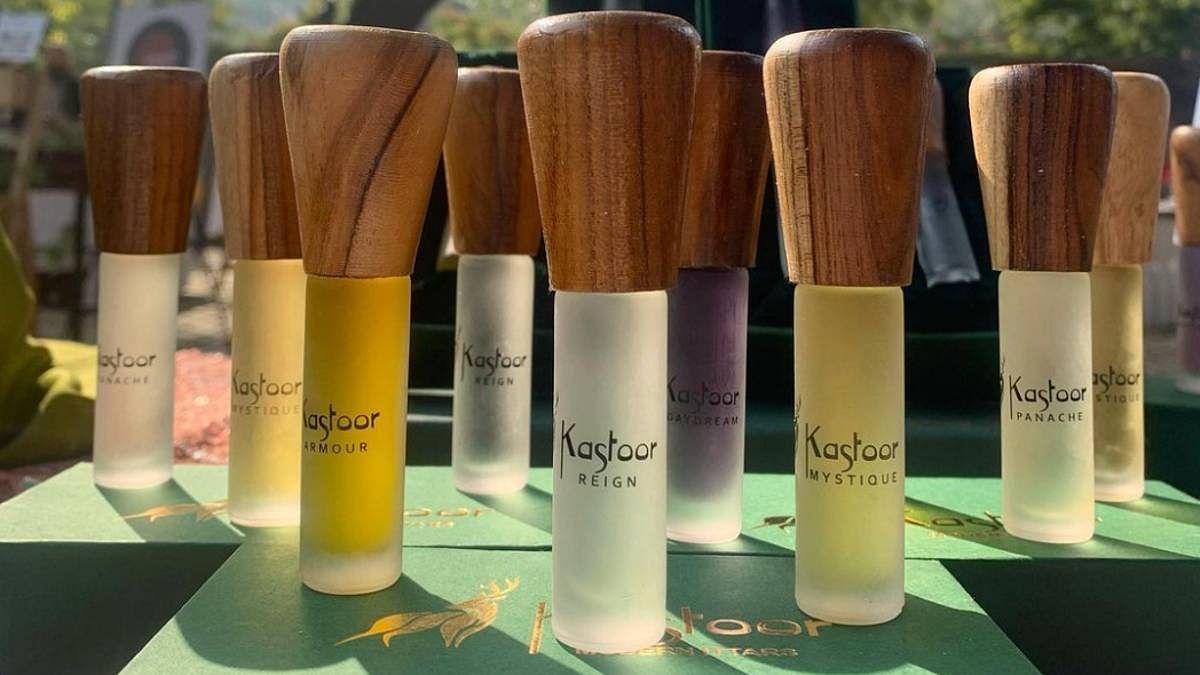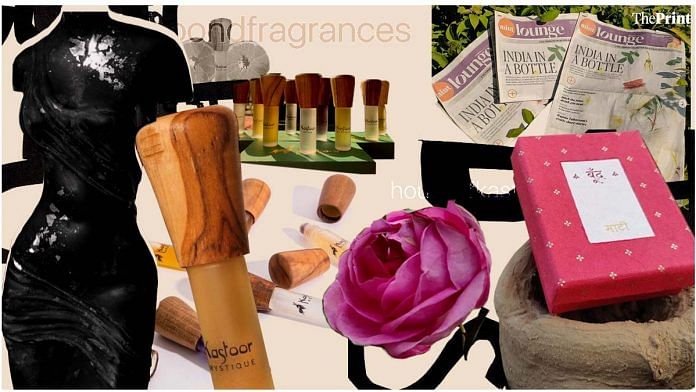New Delhi: India’s indigenous perfume-making industry is undergoing a transformation with a bunch of new companies reinventing the desi attar for the modern market.
From employing research and technology to tweak traditional fragrances, so that they are better suited to younger sensibilities, to using social media, online sales and customer-friendly pop-ups for marketing and retail — these companies are on a mission to ensure that the slowly fading smell of attar (or ittar, as it is popularly called) gets a whiff of new life.
Indian attars have always stood apart from synthetic Western perfumes, deodorants and colognes. Completely natural, these oil-based fragrances have traditionally depended on harnessing the natural perfume of flowers, herbs and spices — rose, jasmine, khas, among others. Typically, each attar was also meant to be used during a particular season. Khas, for example, was a summer attar.
“Since time immemorial, ittars have had the power to cut through the strongest walls, make soldiers put down their weapons and kings talk in poetry. But somewhere in the race of chasing foreign notes, ittars lost their supremacy,” claims a write-up available on the website of Kastoor, one of the new brands seeking to revive the attar market.
Launched last year (the company said it had been involved in research and development for many years prior to this), Kastoor calls itself a “modern ittar” brand specialising in “magnanimously fragrant”, “gender-agnostic” Indian perfumes.
The brand’s founder, Esha Tiwari, rues that, despite the country’s rich heritage in attars, India is nowhere on the global fragrance map. One of the things that has worked against attar in recent years, she feels, is the popular perception of attars being very heavy and potent, likely to cause headaches even if used minimally.
“We have reduced the intensity and changed to notes (descriptors of scents that can be sensed upon the application of a perfume) that are more in tune with today’s generation sensitivities,” Tiwari told ThePrint, describing how she has given a “contemporary edge” to Kastoor perfumes.
Kastoor’s strategy of toning down the fragrances is also followed by Boond Fragrances, another new entrant in the attar market.
The company was launched in May 2021. The company’s co-founder, Varun Tandon, echoed Tiwari, saying that attar has been traditionally known for its pungent fragrance, which is not always appreciated by the younger generation. “By changing the portion of base oil and flower extract, we have tried to make it not just organic and chemical-free but also palatable,” he added.
Also read: Where even drains smell of roses — inside India’s perfumery Kannauj on World Fragrance Day
Losing out to foreign fragrances
The slow decline in the attar‘s fortunes probably started with the economic liberalisation of the 1990s. The globalisation that followed further expanded the presence of foreign perfumes and deodorants in the market. The new scents were not just more fascinating for Indian customers, but often cheaper than handcrafted Indian perfumes (organic attars cost over Rs 1,000, while a bottle of deodorant can be bought for a few hundred rupees).
Not surprisingly, the growing market for these perfumes and body sprays resulted in many Indian cosmetic brands, too, entering the fray. In the heady mix of new frangrances, attars started slowly fading away.

The shrinking attar industry had, however, drawn the attention of not just the Indian media, but also offshore newspapers. Many articles have been written on the plight of India’s traditional perfume industry.
In 2012, the Abu Dhabi-based English daily, The National, chronicled the woes of some of India’s boutique perfumeries on account of the influx of canned deodorants and high-end perfumes from the West.
“The younger kids today like spray-on deodorants. It’s a generation gap. It’s like classical music and pop. You can’t do anything about it,” a 52-year-old perfume-maker was quoted as saying in the article.
Slowly, the perfume makers of Hyderabad and Kannauj — the hub of perfume-making in India — started losing out to perfumes from the West that brought in not just more variety in terms of fragrance, but flooded Indian markets and malls, allowing easier access. Advertisements with celebrities only helped in making them more mainstream, as attars slowly got sidelined.
Over the past two-five years, domestic brands have been trying to bring back the spotlight on India’s perfumes, collectively bringing Kannauj and Hyderabad’s heritage aromas to vanity tables around the world.
Meanwhile, Sugandhco, a heritage perfume brand that dates back to the 19th century, has been reinventing itself and exploring new ways of reaching a younger market. Instead of the traditional dab-on attars, the company now has products that can be sprayed like modern perfumes.
In addition to catering to the domestic market, all three companies said they export to buyers abroad.
The making of attar
In India, attar is made by the distillation of various flowers and herbs. It’s been said that flowers plucked at different times of the day pack different scents. They are generally collected at the break of dawn, to retain their freshness.
For the distillation process, the flowers are put into a deg — huge vessels made of copper which can hold 100kg of flowers of varying sizes — and then capped with clay to keep it tightly packed. The deg is connected to another copper vessel called bhapka, which acts as a condenser and is placed in a water tank. The deg is then place over a fire, while the bhapka distills the steam.
The condensed extract or essence of the flower is then mixed with oil that acts as base to finish the product. Most of the luxury brands prefer sandalwood oil, since it helps the perfume stay on the body longer.
While Tiwari claimed to have refashioned attar by inventing concoctions that are exclusive to her brand (“a balance between Western and Indian fragrances”), Tandon’s Boond hasn’t changed the original or rather “Indianised notes”, which he said he always found fascinating and wanted to introduce to the new generation.
“Those fragrances evoke memories and nostalgia — like maati, which is the smell of rain on dry ground, and motiya (jasmine) that reminds one of the long summer nights, or khas and gulab (rose), which have received an overwhelmingly positive response,” he said.
Tandon spoke of how many Americans and Australians have also shown interest in his perfumes for their distinctive Indian fragrance, and how the business has now expanded abroad. It has been most loved by the NRIs, who, while visiting India, take these perfumes back with them, he said. For them, he added, it is not just a product, but a “piece of their land”.
A lot is in the packaging
While Sugandhco has started using the Western technique of employing alcohol as the base in their attars, Kastoor and Boond claim to have kept their perfumes organic. The contemporariness of their perfumes lies in keeping the notes extremely subtle and innovative packaging, they said.
“We didn’t want the bottles to go out with the traditional yellow caps (used in old attar bottles). Because people do not have the habit of seeing them,” said Tiwari. “Also, it has a different perception in the minds of people… So, if you see a Kastoor bottle, it’s a glass, frosted bottle, eight ml with a large wooden cap. And when we hold exhibitions, it looks beautiful,” she added.

Tandon has gone a step further. While the perfume bottles are packed in a handmade paper box, made from recycled cotton scraps, “each bottle, we send has a custom-made poem. Anyone ordering a fragrance which is a recent launch gets a special handwritten poem,” he said.
The efforts have been appreciated by customers. On its website, Boond includes comments by users.
“The so subtle fragrance of the gulab and motiya are delightful…Thank you so much for reviving such a beautiful craft and helping skilled people retain their craft,” is one comment in the section.
Another refers to the maati fragrance, calling it the most authentic petrichor they had come across. The comment also expresses appreciation for the poem sent with the bottle.
Ishika Malhotra, a talent acquisition lead at Vertex Global Services, told ThePrint how the “redesigned perfumes” by these brands were her favourite things to give as gifts. “Most of my friends are abroad. On their birthdays, I always send something that reminds them of home,” she said. “These new ittars make great gifts since it’s something most of our mothers and grandmothers wore and are symbolic of home.”
(Edited by Poulomi Banerjee)
Also read: How a chemist burnt his hand and gave birth to aromatherapy



